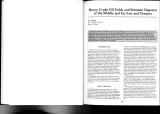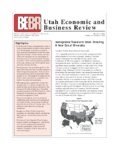TO
1 - 25 of 16
| Title | Date | Subject | Description | ||
|---|---|---|---|---|---|
| 1 |
 |
U.S. Energy Research and Development Administration field experiment | 1976-06 | U. S. energy research and development; field experiment; reverse combustion process; oil recovery; tar sand; alternative forward process | The Laramie Energy Research Center of the U. S. Gov Research and Development Administration is equiping a small-scale field experiment to test the reverse combustion process to recover oil from tar sand. This field experiment, the first of a planned series, will extend the results of laboratory work... |
| 2 |
 |
Oil-impregnated rocks of Utah: USERDA field experiment to recover oil from tar sand | 1976-07 | oil-impregnated rocks; Utah; USERDA; field experiment; recover oil from tar sand; oil recovery | The Laramie Energy Research Center, of the U. S. Energy Research and Development Administration, is equipping a field experiment to test the reverse combustion process for recovery of oil from a tar sand on a 10-acre site on the Northwest Asphalt Ridge deposit near Vernal, Utah. A tar sand section 1... |
| 3 |
 |
Getting from here to there: Devising an optimal regulatory model for CO2 transport in a new carbon capture and sequestration industry | 2010 | regulatory model for CO2 transport; new carbon capture and sequestration; CCS; regulatory model | If CCS is to become a broad-scale commercial industry in time to meet the need for climate change mitigation, the United States must adopt a regulatory model that will allow for efficient construction of critical infrastructure. A well-crafted regulatory framework gives private would-be CCS operator... |
| 4 |
 |
Field experiment of in-situ oil recovery from a Utah tar sand by reverse combustion | 1976 | in-situ oil recovery; Utah tar sand; reverse combustion; oil recovery | Part of the mission of the Energy Research and Development Administration (ERDA) is to develop all energy sources to meet the needs of present and future generations. Toward that mission the Laramie Energy Research Center (LERC) is conducting research and field experiments for the development of rec... |
| 5 |
 |
Fast-tracking Wasatch Front transit investments: economic and demographic impacts of a 2025 build-out | 2011 | Over the next 30 years, the Wasatch Front will significantly expand its transit network. Plans include the construction of an additional 25 miles of light rail, 76 miles of commuter rail, 227 miles of bus rapid transit, and 29 miles of mountain transportation rail line. These projects will be built ... | |
| 6 |
 |
Federal control of carbon capture and storage | 2011-09 | carbon capture; carbon storage; coal; carbon sequestration | The United States has economically recoverable coal reserves of about 261 billion tons, which is in excess of a 250-year supply based on 2009 consumption rates. However, in the near future, the use of coal may be legally restricted because of concerns over the effects of its combustion on atmospheri... |
| 7 |
 |
Heavy crude oil fields and bitumen deposits of the Middle and Far East and Oceania | 1987 | heavy crude oil fields; bitumen deposits; Middle and Far East and Oceania; oil resource | A total of 119 heavy-oil fields are located in the Middle and Far East and Oceania, in 19 countries. Of these, 12 have ultimate recoveries of more than 500 million barrels, and nine of more than 1000 million barrels. About 97% of the total resource of 120,000 million barrels is found in the Middle E... |
| 8 |
 |
Biofuels--snake oil for the twenty-first century | 2008-12-01 | Most Americans are painfully aware that our present consumption of petroleum is unsustainable. The United States has less than 5% of the world's population, but consumes 24.4% of the world's petroleum production. Only 8.5% of the world's petroleum production comes from American wells, which necessit... | |
| 9 |
 |
Oil shale and tar sands | 1976 | oil shale; tar sands; United States; alternative fuels; in situ processing; fractuing tests | To continue its growth or even its existence, the United States must find new energy supplies to replace the petroleum we are rapidly depleting. No fossil energy form can offer a long-range solution, but coal offers a mid-range solution. Unfortunately we're not geared to use it, and learning to appl... |
| 10 |
 |
Revised Utah population estimates for the 1990s | 2001-05 | Every 10 years, the U.S. Bureau of the Census conducts a population count. In the intervening years the Utah Population Es timates Committee (UPEC) annually prepares total resident population estimates for each of the 29 counties in the state. These estimates are based on methods that ut i l i z e s... | |
| 11 |
 |
State and regional control of geological carbon sequestration (Part I) | 2011-05 | state and regional control; geological carbon sequestration; hydrocarbon fuel; carbon capture; geologic sequestration | In the near future the use of coal may be legally restricted due to concerns over the effects of its combustion on atmospheric carbon dioxide concentrations. Carbon capture and geologic sequestration offer one method to reduce carbon emissions from coal and other hydrocarbon fuel. While the federal ... |
| 12 |
 |
Water for commercial oil shale development in Utah: Allocating scarce resources and the search for new sources of supply | 2010 | commercial oil shale development; allocating resources; oil shale; bitumen | BACKGROUND A. What Is Oil Shale and Why Do We Care? Oil shale is a sedimentary rock containing solid bituminous materials. When oil shale is heated, petroleum-like liquids and gasses are released. The process of heating shale and capturing resulting liquids and gasses is called retorting and can occ... |
| 13 |
 |
Immigrants transform Utah: entering a new era of diversity | 2004-05 | Utah is generally perceived as an extremely homogeneous state whose population can trace its ancestry mostly to northern Europe. Listings for surnames like Hansen, Jensen, and Christensen do fill many pages in local telephone directories throughout the state. According to census counts, the minority... | |
| 14 |
 |
Resource evaluation of selected tar-sand deposits in southern Oklahoma | 1987-11-02 | resource evaluation; tar-sand deposits; southern Oklahoma; sulphur deposit; bitumen content | The cooperative program between the Oklahoma Geological Survey and the U.S. Department of Energy has permitted evaluation of specific tar-sand deposits in Carter and Murray counties, Oklahoma. The Sulphur deposit was evaluated by a combination of industry and DOE-OGS boreholes. Bitumen content of th... |
| 15 |
 |
Control of geological carbon sequestration in the western United States | 2011-05 | coal; carbon dioxide; electric utilities; carbon sequestration; sequestration; geological sequestration; climate change | In the near future, the use of coal may be legally restricted due to concerns over the effects of its combustion on atmospheric carbon dioxide concentrations. Carbon capture and geologic sequestration offer one method to reduce carbon emissions from coal and other hydrocarbon fuel. While the federal... |
| 16 |
 |
Tar sand research and development at the University of Utah | 1987 | tar sand research; tar sand development; hydrocarbon recovery; extensive tar sand deposits; in situ thermal production; bitumen; surface mining; hydrocarbon liquid | The recovery of hydrocarbon values from the extensive tar sand deposits of North America has generally been approached by one of two methods: in situ thermal production of the bitumen or of a bitumen-derived liquid or surface mining of the deposit followed by processing of the mined ore. In either a... |
1 - 25 of 16
